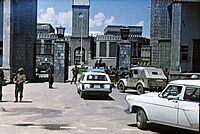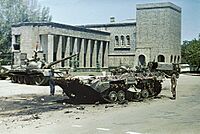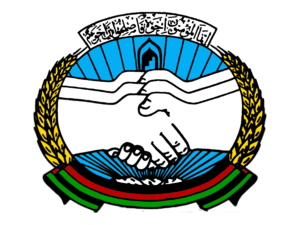People's Democratic Party of Afghanistan facts for kids
Quick facts for kids
People's Democratic Party of Afghanistan
|
|
|---|---|
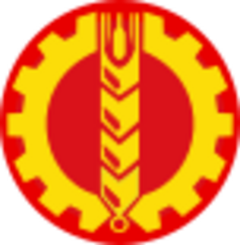 |
|
| Pashto name | د افغانستان د خلق دموکراټیک ګوند |
| Dari name | حزب دموکراتيک خلق افغانستان |
| Abbreviation | PDPA |
| General Secretaries |
|
| Founders | |
| Founded | 1 January 1965 |
| Banned | 6 May 1992 |
| Preceded by |
|
| Succeeded by |
|
| Headquarters | Kabul, Afghanistan |
| Newspaper |
|
| Youth wing | Democratic Youth Organisation of Afghanistan |
| Membership (late 1980s) | 160,000 |
| Ideology |
|
| Political position | Far-left After 1987: Left-wing |
| National affiliation |
|
| Colors | Red and yellow |
| Party flag | |
 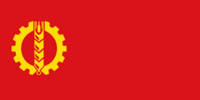 |
|
The People's Democratic Party of Afghanistan (PDPA) was a political party in Afghanistan. It was started on January 1, 1965. The party followed ideas like Marxism-Leninism, which is a type of communism.
For most of its time, the PDPA was divided into two main groups: the Khalq (meaning "Masses") and the Parcham (meaning "Banner") factions. Each group believed it was the "true" PDPA. The party was very supportive of the Soviet Union.
The PDPA helped Mohammad Daoud Khan overthrow King Mohammad Zahir Shah in 1973. This led to the creation of the Republic of Afghanistan. At first, many PDPA members were in the government. But later, their relationship with President Daoud Khan got worse.
In 1978, the PDPA, with help from the Afghan Army, took power from Daoud Khan. This event is known as the Saur Revolution. The PDPA, led by Nur Muhammad Taraki, then formed the Democratic Republic of Afghanistan. This government lasted until 1987.
Later, in 1990, under the leadership of Mohammad Najibullah, the party changed its name to the Homeland Party. It also moved away from its original communist ideas. The government it led fell in 1992 when rebels took over Kabul. The PDPA was then officially dissolved.
Party History
Nur Muhammad Taraki began his career as a journalist in Afghanistan. On January 1, 1965, he and Babrak Karmal founded the People's Democratic Party of Afghanistan. At first, they called themselves the People's Democratic Tendency. This was because parties that were against the monarchy were not allowed.
The PDPA was officially formed when different groups of the Socialist Party of Afghanistan came together. Twenty-seven men met at Taraki's house in Kabul. They chose Taraki as the first leader and Karmal as his deputy. The party was known for its strong connections with the Soviet Union.
The PDPA was able to get three members into the Afghan parliament in the first free elections. These members were Karmal, Anahita Ratebzad, and Nur Ahmed Nur. Taraki also started the first radical newspaper in Afghanistan, called The Khalq. However, the government stopped its publication in 1966.
Khalq and Parcham Groups
In 1967, the PDPA split into different groups, with Khalq and Parcham being the largest. These divisions happened because of different ideas and economic goals. Most Khalq supporters were Pashtuns from rural areas. Parcham supporters were mainly city people who wanted social and economic changes.
The Khalq group accused the Parcham group of being loyal to King Mohammed Zahir Shah. This was because the Parcham newspaper was allowed by the king. The split was not announced publicly, but Karmal left with less than half of the party's main committee members.
Because of these internal problems, the party's representation in the Afghan parliament dropped. In 1973, the PDPA helped Mohammed Daoud Khan take power from King Zahir Shah in a peaceful military takeover. Daoud then created the Republic of Afghanistan. However, his new constitution in 1977 made him lose support from many of his political friends.
Coming Back Together
The Soviet Union played a big part in getting the Khalq group (led by Taraki) and the Parcham group (led by Karmal) to reunite. In March 1977, they agreed to unite. In July, they held their first joint meeting in ten years. Both groups had been in contact with the Soviet government since their split in 1967.
Both the Khalq and Parcham groups were always supportive of the Soviet Union. There were suggestions that they received money and other help from the Soviet embassy. However, the Soviets were also close to King Zahir Shah and President Daoud Khan, so direct financial help was not openly proven.
Taraki and Karmal kept in close touch with Soviet officials in Kabul. It seems that Soviet military intelligence helped the Khalq group recruit military officers.
The Saur Revolution
In 1978, a key member of the Parcham group, Mir Akbar Khyber, was believed to have been killed by the government. Even though the government denied it, PDPA members feared that President Mohammad Daoud Khan planned to eliminate them all. After a large protest at Khyber's funeral, most PDPA leaders were arrested.
However, Hafizullah Amin, a Khalq leader, managed to stay out of prison long enough. He organized an uprising with military officers who supported the Khalq faction. On April 28, 1978, military units loyal to the Khalq group stormed the Presidential Palace in Kabul. This day was chosen because it was the day before Friday, a Muslim day of rest.
Tanks, led by Major Aslam Watanjar, were used in the takeover. With help from the Afghan air force, the rebel troops defeated the Presidential Guard. President Daoud and most of his family were killed. Hafizullah Amin renamed the country the Democratic Republic of Afghanistan.
New Government and Reforms
The PDPA took over from Daoud's government. Nur Muhammad Taraki of the Khalq faction became the Prime Minister. Babrak Karmal was the senior Deputy Prime Minister, and Hafizullah Amin was the foreign minister.
Once in power, the PDPA started a program of quick changes. They wanted to separate religion from the government, end illiteracy (most people couldn't read or write), reform land ownership, give more rights to women, and stop old feudal practices. They also changed the national flag to a Soviet-style one.
Old customs like usury (lending money at very high interest), bride price (money paid to the bride's family), and forced marriage were banned. The minimum age for marriage was raised. The government pushed for education for both men and women and started a big campaign to teach people to read. They also discouraged men from having long beards.
These changes were not popular with most Afghans, especially in rural areas. Many saw them as against Islamic teachings and as forcing Western culture onto Afghanistan. The government's new policies clashed with traditional Afghan beliefs. This made religion a strong force that united people against the new government.
Harsh Rule and Soviet Involvement
The new government began a period of harsh rule. Many people were arrested, and some died, especially at Pul-e-Charkhi prison. Despite fears, no restrictions were placed on religious practices at first.
In 1979, Soviet special forces stormed the Tajbeg Palace and killed PDPA leader Hafizullah Amin. Babrak Karmal then became the new Afghan leader. The Soviet-Afghan War began after Amin's death. Karmal was later sent to Prague to be the Afghan ambassador there.
The rivalry between the Khalq and Parcham groups continued, sometimes leading to fights and deaths. Moscow eventually saw Karmal as unsuccessful. In May 1986, Mohammad Najibullah replaced Karmal as the party leader. Karmal then moved to Moscow.
National Reconciliation and End of the Party
After the Soviet Union destroyed many villages, the PDPA government faced growing opposition from Mujahideen fighters. These fighters were trained in Pakistan with support from the United States.
The Soviet Union withdrew its troops in 1989. However, they continued to provide military help to the PDPA government until the USSR broke apart in 1991.
The Homeland Party
The Soviet troop withdrawal weakened the PDPA government. In March 1990, Defense Minister Shahnawaz Tanai tried to take power in a military coup, but it failed. Najibullah remained president. In June 1990, he renamed the party the Homeland Party. The party officially dropped its Marxist-Leninist ideas.
In 1991, the Soviet Union dissolved, and all support for the Afghan government stopped. In April 1992, the PDPA government collapsed. This happened after General Abdul Rashid Dostum changed his support following President Najibullah's resignation. The party was officially banned on May 6, 1992. Some former PDPA officials joined the new government, others joined militias, and some left.
Party Ideas
Since 1919, the Soviet Union had a strong influence on Afghanistan's politics, economy, and military. Many Afghan students and military trainees in the USSR learned about Marxism-Leninism. Some of them adopted these ideas.
Nur Muhammad Taraki, the first PDPA leader, became interested in communism during his studies in India in 1932. Hafizullah Amin, the second leader, also developed leftist beliefs while studying in the United States. Taraki and Babrak Karmal were said to have been Soviet agents since the 1950s.
From its start in 1965, the PDPA called itself "national democratic," not communist. However, it was clearly pro-Soviet. The party's secret constitution from 1965 called for "strengthening Afghan-Soviet friendly relations." A party history in 1976 stated that the party fought against "American imperialism" and supported the Soviet Union.
After the Saur Revolution in April 1978, Taraki said the PDPA were nationalists and revolutionaries but not communists. He also promised to support Islam within a secular state. But once in power, it became clear that the PDPA was made up mostly of educated city people. They did not have much support in the rural, Islamic communities of Afghanistan.
The party started a program of radical changes, like redistributing land and giving more rights and education to women. These changes went against traditional customs and religious laws. The radical reforms, anti-imperialist talk, and increased Soviet presence led to the international media calling the PDPA "communist."
Some people who supported Mohammed Najibullah later relaunched the Hezb-e Watan party in 2004 and again in 2017.
Party Structure
The PDPA had a structure similar to the Communist Party of the Soviet Union.
Party Meetings
The party held congresses (large meetings) to make important decisions:
- 1st Congress (1967)
- 2nd Congress (1987)
Central Committee
The Central Committee was a key leadership group. Its members changed often due to political events and leadership changes. For example, after Taraki was removed in 1979, many members were replaced. When Babrak Karmal took power, he brought back some members who had been removed earlier.
The Central Committee grew over time. In 1983, it had 52 full members and 27 candidate members. Only a few members stayed in their positions through all the leadership changes.
Leaders and Main Bodies
The Politburo and Secretariat were the main executive and legislative bodies of the PDPA. The Politburo made decisions, and the Secretariat carried them out. These bodies usually had between 7 and 9 members.
The main leaders of the party were:
- Nur Muhammad Taraki, 1965–1979
- Hafizullah Amin, 1979
- Babrak Karmal, 1979–1986
- Mohammad Najibullah, 1986–1992
Local Organizations
From 1982, the PDPA tried to expand its organization into rural areas. The number of local party committees grew. However, a major problem was that most mid-level party leaders lived in Kabul, not in the areas they were supposed to manage. This meant the central leadership had little contact with local groups or the people.
The party tried to improve this by appointing village-level party secretaries to the Central Committee. They also increased visits by central party members to the provinces. However, dangerous conditions in the countryside made it hard for party members to work there.
Party Members
When the PDPA took power, it had about 5,000 to 7,000 members. By 1984, this number grew to between 20,000 and 40,000 members. This increase was due to efforts to recruit members in government offices, state-owned businesses, and the military.
By 1982, about half of the party members were in the armed forces. Many new members joined because of opportunities rather than strong belief in the party's ideas. After the Soviet intervention, the party made it easier to join to increase membership. However, many new recruits had low education levels, which lowered the overall quality of party members.
Youth Organization
The party had a youth wing called the Democratic Youth Organization of Afghanistan.
Later Parties
In 1997, the Watan Party of Afghanistan was formed. It tried to register using the old PDPA name but was not allowed.
In 2003, the National United Party of Afghanistan was registered. This party aimed to unite former PDPA members.
|


